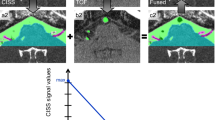Purpose:
To present a simple and precise method of combining functional information of cranial SPECT and PET images with CT and MRI, in any combination.
Material and Methods: Imaging is performed with a hockey mask-like reference frame with image modality-specific markers in precisely defined positions. This frame is reproducibly connected to the VBH vacuum mouthpiece, granting objectively identical repositioning of the frame with respect to the cranium. Using these markers, the desired 3-D imaging modalities can then be manually or automatically registered. This information can be used for diagnosis, treatment planning, and evaluation of follow-up, while the same vacuum mouthpiece allows precisely reproducible stereotactic head fixation during radiotherapy.
Results: 244 CT and MR data sets of 49 patients were registered to a root square mean error (RSME) of 0.9 mm (mean). 64 SPECT-CT fusions on 18 of these patients gave an RMSE of 1.4 mm, and 40 PET-CT data sets of eight patients were registered to 1.3 mm. An example of the method is given by means of a case report of a 52-year-old patient with bilateral optic nerve meningioma.
Conclusion: This technique is a simple, objective and accurate registration tool to combine diagnosis, treatment planning, treatment, and follow-up, all via an individualized vacuum mouthpiece. Especially for low-resolution PET and even more so for some very diffuse SPECT data sets, activity can now be accurately correlated to anatomic structures.
Ziel:
Vorstellung einer einfachen und präzisen Methode zur Korrelation nuklearmedizinischer Bildgebung (SPECT und PET) des Schädelbereichs mit CT und/oder MRT.
Material und Methodik: Die Bildgebung erfolgt mit einem externen helmartigen Referenzrahmen mit integrierten modalitätsspezifischen Markern an definierten Positionen. Die genaue Relation des Rahmens zum Schädel ist durch reproduzierbares Aufstecken auf das VBH-Vakuummundstück gewährleistet. Mittels dieser Marker können die jeweiligen Datensätze manuell oder (halb)automatisch registriert werden. Die so fusionierten Bilder können in der Diagnostik, Bestrahlungsplanung und Nachsorge eingesetzt werden; das Vakuummundstück dient gleichzeitig der präzisen Lagerung bei fraktionierter stereotaktischer Bestrahlung.
Ergebnisse: 244 CT- und MRT-Datensätze von 49 Patienten wurden mit einem durchschnittlichen “root square mean error” (RSME) von 0,9 mm überlagert, während an 18 Patienten 64 CT-SPECT-Fusionen zu einem RSME von 1,4 und 40 CT-PET-Datensätze von acht Patienten zu 1,3 mm fusioniert wurden. An einer 52-jährigen Patientin mit bilateralem Optikusscheidenmeningiom wird die Methode beispielhaft demonstriert.
Schlussfolgerung: Diese Methode ist ein einfaches, objektives und genaues Verfahren zur Registrierung multimodaler Datensätze. Insbesondere die Integration von Datensätzen mit niedriger Auflösung (PET und SPECT) erlaubt bedeutende Einblicke in klinische Vorgänge, die teilweise aus CT bzw. MRT nicht ersichtlich sind.
Similar content being viewed by others
Author information
Authors and Affiliations
Additional information
Received: April 8, 2002; accepted: October 21, 2002
RID="*"
ID="*"Presented at: DEGRO/ÖGRO/DGMP, Munich, Germany, October 2000 (Elekta Poster Award for functional imaging and treatment planning), ASTRO 2001, San Francisco, CA, USA, and RSNA 2001, Chicago, IL, USA.
Correspondence Address Dr. Reinhart A. Sweeney, Department of Radiotherapy-Radiooncology, University Hospital Innsbruck, Anichstraße 35, 6020 Innsbruck, Austria, Phone (+42/512) 504-2800, Fax -2812, e-mail: reinhart.sweeney@uibk.ac.at
Rights and permissions
About this article
Cite this article
Sweeney, R., Bale, R., Moncayo, R. et al. Multimodality Cranial Image Fusion Using External Markers Applied via a Vacuum Mouthpiece and a Case Report. Strahlenther Onkol 179, 254–260 (2003). https://doi.org/10.1007/s00066-003-1031-2
Issue Date:
DOI: https://doi.org/10.1007/s00066-003-1031-2




